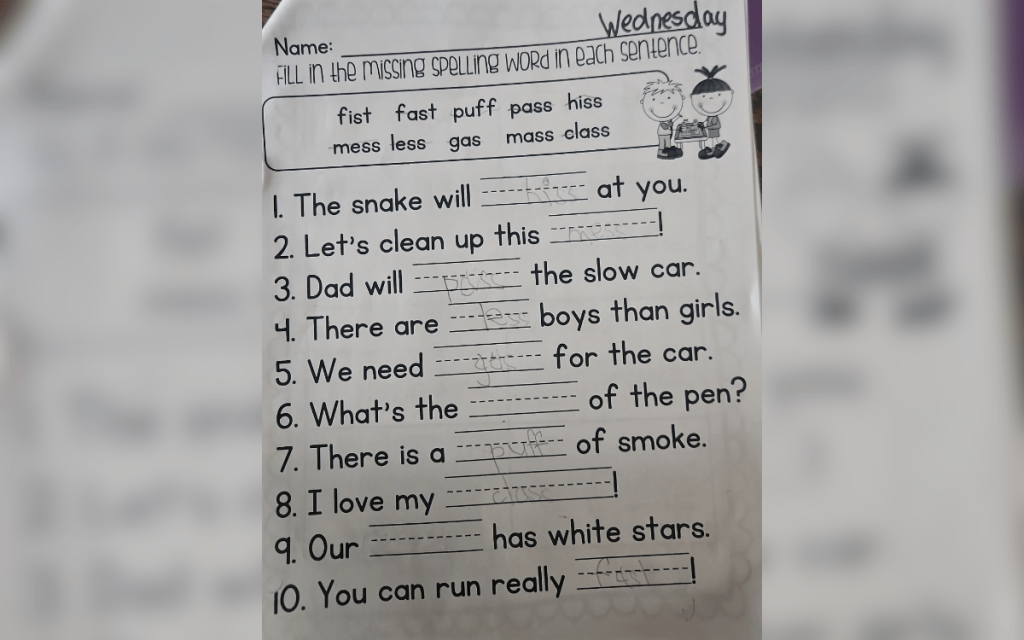When Homework Leaves Parents Scratching Their Heads
In an age of advanced technology and instant information, one might think elementary school homework would be a breeze for adults. Yet across the internet, parents regularly find themselves completely stumped by their children’s assignments, turning to online communities for help. These perplexing homework problems have become something of an internet phenomenon, with the most viral posts featuring assignments that seem either impossibly difficult or fundamentally flawed. From confusing language exercises to mathematical problems that don’t add up, these assignments have left not just children but entire online communities baffled, wondering if education has changed dramatically since they were in school or if something has gone terribly wrong with modern curriculum design.
The struggle is real for parents like Gary, who in 2024 found himself at a loss when helping his first-grader with what should have been a simple fill-in-the-blank vocabulary exercise. While the worksheet started innocuously enough with sentences like “The snake will [hiss] at you” and “Let’s clean up this [mess],” it soon presented seemingly impossible challenges. Questions such as “What’s the [blank] of this pen?” and “Our [blank] has white stars” left both father and child confused, as none of the provided words (fist, fast, puff, pass, hiss, mess, less, gas, mass, class) seemed to fit naturally. Though some Reddit users suggested “mass” might work for the pen question, many questioned how a first-grader would understand such a concept. For the stars question, people guessed “flag” would make sense, but this word wasn’t among the options. Gary ultimately found comfort in the online consensus that the worksheet itself contained errors, telling Newsweek, “It was a relief to know I wasn’t just dumb. There being no obvious answer except that it was an error.”
Mathematics assignments seem to cause particular confusion, sometimes defying not just parents’ understanding but even challenging the expertise of math professionals. One viral Reddit post featured a fifth-grade math problem asking students to calculate how much paint Marvin would need for 37 walls if he uses 0.34 gallons per wall. The twist? Instructions directed students to “round each decimal to the nearest whole number” before calculating. This led to the absurd conclusion that since 0.34 rounds to 0, Marvin would need 0 gallons of paint for 37 walls—an answer the teacher reportedly confirmed as correct. This problem outraged online commenters and even prompted Julia Smith, a UK-based mathematics specialist, to call it “bonkers,” explaining that conventional mathematical practice dictates rounding should occur after multiplication, which would yield approximately 13 gallons. This disconnect between practical application and academic instruction illustrates why many students struggle with mathematics, as one commenter noted: “This is why math is difficult for so many people, we try to make it relatable but just make nonsense questions as a result.”
Even seemingly simple problems can become mind-bending when presented with unusual instructions. A first-grade math problem that went viral asked students to “prove that 4 + 2 = 5 + 1 is true without solving both sides of the equation.” The father who shared this conundrum admitted he struggled to think like a child just learning basic arithmetic. While many Redditors considered the problem inappropriate for first-graders, requiring “higher level math or cognitive thought,” a self-identified first-grade teacher defended it as encouraging conceptual understanding beyond mere memorization. The teacher explained the intended solution involved showing equality through step-by-step regrouping: “4+2=5+1, 4+1+1=5+1, (4+1)+1=5+1, 5+1=5+1.” This debate highlights the tension between traditional approaches to elementary math education and newer methods that emphasize conceptual understanding, with parents often caught in the middle, unsure how to help their children navigate unfamiliar pedagogical territory.
Sometimes, homework problems create unintentional humor through poor wording or oversight. A pie chart problem for 11-year-olds in the UK asked what percentage of 20 children chose the zoo or theater as field trip destinations, when 65% had selected a theme park and the remaining children were evenly split between the other two options. While the mathematical answer was clearly 17.5% for each, the problem sparked jokes about “half children,” with the parent reporting they spent “10 minutes or more discussing the inevitable poor half children.” The post garnered 7 million views on Reddit, with commenters humorously speculating how “the 0.5 children shall merge together to be a new child.” Such problems, while mathematically sound, reveal how literal interpretation can create amusing mental images that distract from the intended learning objective.
The start of each school year brings a fresh wave of perplexing homework posts, as evidenced by a recent alphabet worksheet that went viral on Threads. While most letters had clear corresponding images—L for leaf, N for net, O for ox—the letter M was paired with four identical boxes containing dots in the middle, leaving parents completely confused. More than 5,000 people responded with suggestions ranging from “Mahjong” to “Mmcheez-its,” before a language teacher finally explained the answer was likely “many” or “multiple.” This explanation was met with skepticism from some users, with one commenting, “If that’s the case, M is clearly for ‘mind games.'” These viral homework mysteries serve as more than just entertainment; they highlight genuine challenges in educational communication between schools and families. When parents can’t understand homework well enough to assist their children, it creates frustration and potentially undermines learning objectives. Perhaps these internet communities, where confused parents seek collective wisdom, offer not just answers but also a comforting reminder that even in education, sometimes the emperor has no clothes—and it’s okay to admit when instructions simply don’t make sense.


